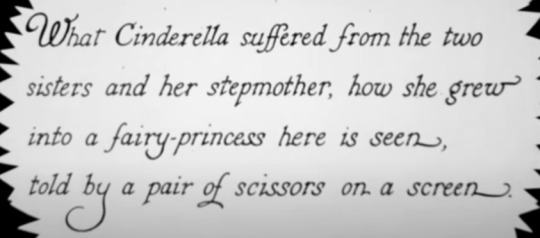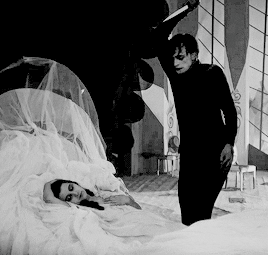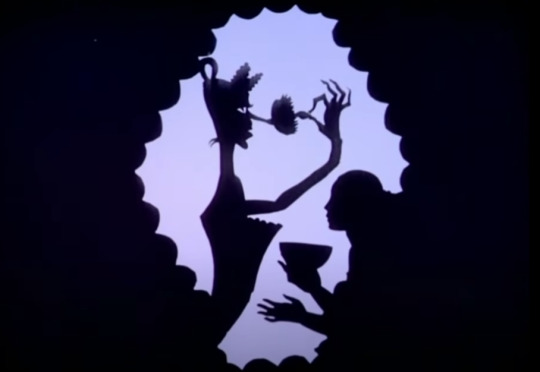#1920sanimation
Explore tagged Tumblr posts
Text
Lotte Reiniger (1920s): An Inspiration to Modern Animation Directors
(10 minutes reading)
By Sofi Ojeda

Lotte Reiniger was a talented German artist born in Berlin, she displayed remarkable, self-taught skills in creating intricate paper silhouettes from an early age. She incorporated these silhouettes into her homemade shadow theater with the influences she drew from traditional Asian shadow plays. Reiniger's talent led to an introduction to her later partner Koch, who not only designed her animation studio but also served as her producer and camera operator until his death in 1963.
Reiniger's enduring fascination with timeless fairy tales permeated her animations, including notable works such as "Aschenputtel" (Cinderella) and "Dornröschen" (The Sleeping Beauty) from 1922. However, her most remarkable achievement was "The Adventures of Prince Achmed," a pioneering project created in collaboration with her husband and others over three years, celebrated as the first full-length animated film in history.

Although, Reiniger created various works in different countries before and after the war, she never ventured into another full-length feature film. Nevertheless, her unique animation style continues to exert a profound influence on a diverse range of cinematic creations, from Disney classics to the enchanting world of Harry Potter, leaving an indelible mark on the realm of animation.
Pioneering Techniques

Furthermore, Reiniger's legacy transcends her era, as her pioneering techniques, including cut-out animation (where body parts are separated and manipulated with anchor points and a skeletal structure). And her silhouette art underscores one of the most recognized design principles—silhouette—in character design and object recognition. This principle facilitates viewers' comprehension of visual information and enhances their grasp of the narrative.
Having gained insight into her techniques, let's explore some examples of her influence.
Inspiration to Animation Directors Over Time
Reiniger influence on Walt Disney

She inspired Disney to incorporate the concept of the multiplane camera into animation. This innovative camera technique involved the use of multiple layers of drawings moving at varying speeds, effectively creating a sense of depth and dimension in the video.
Reiniger influence on Tim Burton

In Tim Burton's "Corpse Bride" (2004), a traditional interpretation of Reiniger's style surfaces in a scene during the musical number 'Remains of the Day.' Utilizing silhouettes set against vibrant green backgrounds, the narrative unfolds, reminiscent of Reiniger's shadow animations.
Reiniger influence in Ford Coppola

The opening scene of Francis Ford Coppola's "Bram Stoker's Dracula" (1992) serves as a clear illustration of this phenomenon. It involves the recounting of Vlad 'The Impaler' Dracula's history, shifting from a live-action sequence to a battle montage that adopts Reiniger's distinctive artistic style.
Lotte R. influence in Harry Potter

In "Harry Potter and the Deathly Hallows – Part 1" (2010), there's a noteworthy transition from live-action to animation as Harry, Ron, and Hermione delve into 'The Tale of the Three Brothers.' To honor Reiniger's iconic storytelling style, which often resembled classic fables, the filmmakers opted for this approach
Conclution
From a gender perspective, it appears that Lotte Reiniger existed in a parallel world where her voice as a woman was not only acknowledged but also illuminated across time to the present day. It's worth noting that she seemed to be the sole practitioner of her unique animation technique, and had she worked in a male-dominated field, the course of history might have unfolded quite differently. However, I am not implying that she didn't face the challenges that were prevalent in her time.
In summation, Lotte Reiniger's contributions to the world of animation stand as a testament to her inventive spirit and pioneering endeavors. Her mastery of shadow animation, her lasting impact on modern animation techniques, and her feminist legacy collectively leave an enduring impression on the cinematic landscape. Her influence continues to inspire filmmakers and animators to this day.
Bibliography
http://www.screenonline.org.uk/people/id/528134/index.html
https://www.acmi.net.au/stories-and-ideas/lasting-legacy-lotte-reiniger/
#art#illustration#lotte reiniger#animation history#1920sanimation#earlyanimations#writing#animationblog#2d animation#animation#cutout#tim burton#walt disney#harry potter#bram stocker's dracula#francis ford coppola
8 notes
·
View notes
Photo

Enjoyed drawing this yesterday. I had the art, but couldn’t think of a saying to go with it at first. Not sure if it makes sense, but I got a kick out of it. Now it’s available to buy on all sorts of shirts, stickers, coffee mugs, etc. at https://bensanczel.com/shop
0 notes
Text
Exploring Lotte Reiniger's 'Cinderella' Through the Eyes of a Silhouette Animator and Feminine Depth
(5 minutes reading)
By Sofi Ojeda

Lotte Reiniger, a trailblazing German animator renowned for her pioneering work in paper silhouette animation, has had a profound impact on the animation industry. Inspired by ancient Asian performances, Reiniger's legacy extends beyond her creation of the first full-length animated feature film, "The Adventures of Prince Achmed (1926)".
Today, we explore one of her lesser-known yet highly significant earlier works, "Aschenputtel" (Cinderella), crafted in 1922. This journey allows us to appreciate Reiniger's artistic brilliance and invites us to delve into the deeper layers of meaning within this classic fairy tale.
Understanding the Narrative
An intriguing element that I loved of this 12-minute short film lies in its opening sequence, where we witness Reiniger's hands meticulously crafting the paper main character Cinderella. Notably, Reiniger imbues the scissors with a character of their own, introducing them as a threat to Cinderella. This powerful and symbolic commencement aligns seamlessly with the film's overarching narrative: "Cinderella" is a young woman who manages to defy formidable challenges and secures an invitation to a royal ball, ultimately winning the affection of a prince, or as she eloquently phrases it:

(Indeed, she also created these stunning English-written cards.)
Silhouette Animation Technique
Reiniger employed a frame-by-frame photography technique using multiple layers of cut-out paper. By adjusting opacity and composition, she crafted an illusion of depth in a multiplane camera—a technique later adopted by Walt Disney. Adding depth to the character designs through exaggeration, shape language and acting. Even the inanimate objects in the film are imbued with a distinct German expressionism style—distorted yet still legible. Remarkable for its time and the work of a single individual.

(German expressionism movie: The Cabinet of Dr. Caligari (1920))
Feminine Insights

Reiniger's "Cinderella" isn't just a retelling of the classic fairy tale—it's an exploration of femininity, vanity, and competition among women. The film uses humor, such as the comically exaggerated eye movements of characters, to ridicule vanity. It reflects a historical perspective where differences in femininity were exploited for competition. Today, we recognize that there's no one way to be feminine, and no one is better or worse for their choices.
youtube
In the tale, her stepsister goes to extraordinary lengths, even resorting to cutting a part of her own feet to squeeze into Cinderella's shoe. This vividly illustrates how, in the past, cinema and television often portrayed the extraordinary measures women were willing to take to gain acceptance and validation from figures like princes or men in general. While we may find her stepsister's actions unconventional, it offers a poignant glimpse into the immense hurdles women confronted in their quest to meet societal expectations, as they strived to fit into predefined molds and be valued accordingly.
A Lasting Legacy
Reiniger produced two unique adaptations of this story. The first (this one), is a silent version that closely follows the German Grimm rendition, replacing the fairy godmother with a magical tree. And the second was her 1954 version, which reintroduced the fairy godmother, along with components like a pumpkin coach and mouse footmen, despite the story's origin in Perrault's version.
Reiniger's "Cinderella" has left a lasting impact. It's intriguing to note that subsequent adaptations, including Disney's iconic version, have closely followed the story's original narrative. Cinderella's tale is one of the most remade stories in cinematic history, with over 100 adaptations on the big and small screens.
youtube
If you're curious to experience this classic work, here I attatched "Cinderella" short film (posted on YouTube), where its timeless charm continues to captivate audiences, just as it did nearly a century ago.
Bibliography
The Art of Lotte Reiniger, 1970 | From the Vaults (on youtube)
Movie: The Cabinet of Dr. Caligari (1920)
Blogs:
https://moviessilently.com/2018/03/18/cinderella-1922-a-silent-film-review/
https://www.skwigly.co.uk/100-greatest-animated-shorts-cinderella-lotte-reiniger/
http://www.screenonline.org.uk/people/id/528134/index.html
#2d animation#animation#writing#art#movies#1920sanimation#lotte reiniger#cinderella#movie critique#movie critic#short film#animation history#animationblog#Youtube
3 notes
·
View notes